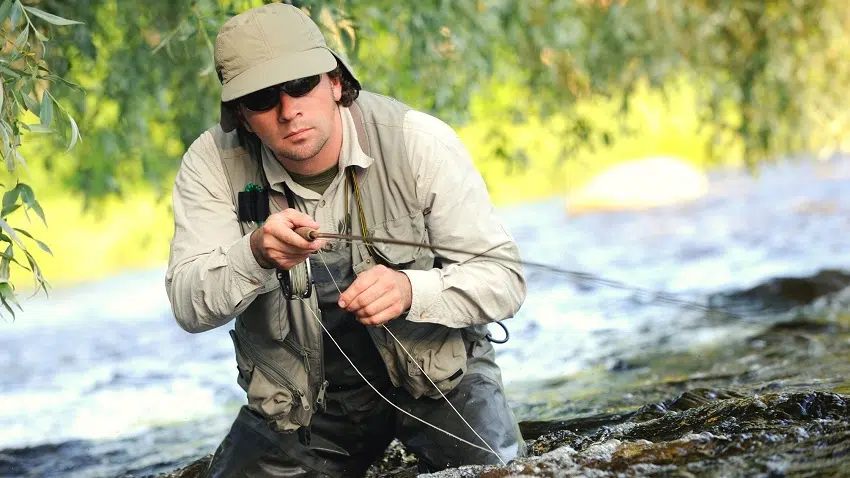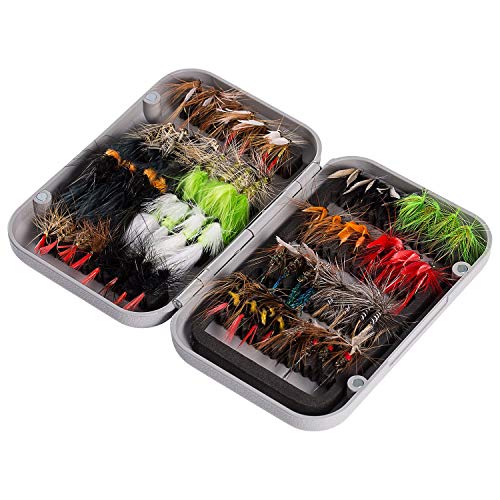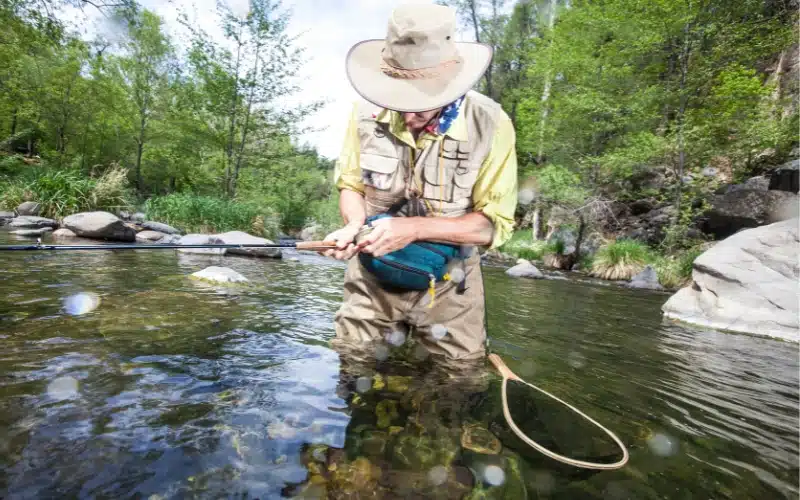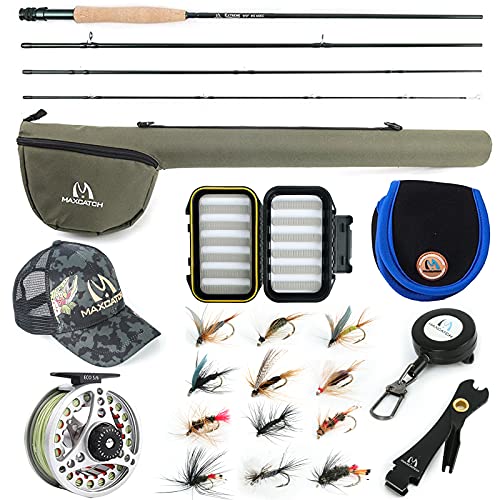Fly fishing is a beautiful and serene sport that has been around for centuries. Unlike traditional fishing, which relies on a heavier line and bait to lure fish, fly fishing employs a lightweight fly to imitate various insects and attract the fish. But how does fly fishing work?
It is an art that requires patience, skill, and a deep understanding of aquatic ecosystems. But how exactly does fly fishing work? In this article, we will delve into the mechanics of fly fishing, exploring everything from the equipment used to the fly fishing techniques employed by anglers.
At its core, fly fishing is a method of fishing where an angler uses a specialized fly rod and reel to cast a lightweight fly line with an artificial fly attached. The fly line, which is much thinner and lighter than traditional fishing lines, allows the fly fishers to deliver the fly to the fish with precision and delicacy.
By mimicking the movements of insects that fish prey upon, the angler lures the fish into thinking that the fly is a potential food source, convincing them to strike.
Fly fishing requires finesse and sensitivity, as the angler must carefully manipulate the fly to create realistic movements that will entice the fish. So, let’s dive into the fascinating world of fly fishing and uncover the secrets behind this captivating sport.
Quick Jump
ToggleHow Does Fly Fishing Work?
Fly fishing is a contemplative art of angling that uses a fly rod, reel, line, and weighted artificial flies to mimic the natural movements of aquatic insects and other tiny organisms.

In fly fishing, a distinctive casting technique harnesses the intrinsic power of the “weight of the line” to propel the leader, linked to the fly, precisely to its intended destination.
Here is a step-by-step overview of how fly fishing works:
- Choose the right fly. Fly fishing flies are designed to imitate natural food sources for fish, such as insects, baitfish, and crustaceans. The fly you choose will depend on the kind of fish you are targeting and the conditions in which you are fishing.
- Cast the fly. Fly casting is a unique skill that takes practice to master. The basic technique is to use the fly rod to create a loop of fly lines in the air. The fly is attached to the end of the leader, which is a section of monofilament or fluorocarbon line that connects the fly line to the fly. As the fly line loop unfurls, the fly is pulled through the air and lands on the water.
- Retrieve the fly. Once the fly is in the water, you need to retrieve it in a way that imitates the movement of its natural counterpart. For example, if you are fishing for a dry fly, you would retrieve it in a form that makes it look like an insect floating on top of the water.
- Set the hook. When a fish strikes at the fly, you need to set the hook by quickly lifting the rod tip. This will drive the hook into the fish’s mouth.
- Play the fish. Once the fish is hooked, you need to play it carefully to avoid breaking the line or losing the fish. Once the fish is tired, you can reel it and land it.
Fly fishing can be a challenging but rewarding sport. It is a great way to enjoy the outdoors and catch fish in various settings.
- FLY FISHING COMBO includes: ONE Fly Rod(9 ft, 5/6 weight, 4 pc...
- THE ROD: 4 sections designed medium fast action fly fishing rods,...
- THE REEL: This fly reel is made of CNC-machined 6061-T6 aluminum...
- The combo includes everything that you will need to start fly...
- FLY ROD COMPONENTS: Weighing just 4.4 ounces, this well-crafted...
- DURABLE FLY REEL: This fly fishing package includes a durable die...
- WATERPROOF FLY BOX WITH NINE FLIES: As any angler knows, the key...
- PROTECTIVE ROD CASE AND REEL BAG: The Wild Water Fly Fishing...
- Everything You Need To Go Fishing: Includes a performance9’, 5...
- Exclusive MAXLINQ Rod Technology: Pure IM7 24T plus 30T carbon...
- Distance and Presentation: A fast action design rod blank to...
- Pre-Loaded Aluminum Reel: An aluminum lightweight reel with an...
What’s the Difference Between Traditional Fishing and Fly Fishing?
The main difference between traditional fishing and fly fishing is the type of tackle used. In traditional fishing, a weight is attached to the fishing line to cast the lure or bait fish into the water. In fly fishing, a weighted fly line casts the lightweight fly. This difference in tackle leads to several other differences between the two fishing methods, including:
- Equipment: Traditional fishing tackle is typically more straightforward and less expensive than fly fishing tackle. Fly fishing rods are more delicate and require special casting techniques.
- Casting: Casting a fly rod is a more complex skill than casting a traditional fishing rod. Fly anglers must learn to falsely cast, a technique used to generate the power to cast the fly line.
- Presentation: Fly anglers typically try to present their flies more naturally than traditional anglers. This means casting the fly upstream and letting it drift down to the fish or casting the fly to imitate a specific insect or baitfish.
- Target fish: Fly fishing is often used to catch trout, typically found in moving water. Traditional fishing can acquire a wider variety of fish, including trout, bass, catfish, and panfish.
Here is a table summarizing the key differences between traditional fishing and fly fishing:
| Characteristic | Traditional fishing | Fly fishing |
|---|---|---|
| Equipment | Simpler and less expensive | More delicate and specialized |
| Casting | Easier to learn | More complex to learn |
| Presentation | Less emphasis on natural presentation | More emphasis on natural presentation |
| Target fish | Can be used to catch a wide variety of fish | Often used to catch trout |
Which type of fishing is better depends on your preferences and the fish you want to catch. Traditional fishing is a good option if you are looking for a simple and effective way to catch fish. If you want a more challenging and rewarding fishing experience, fly fishing is a good choice.
It is also worth noting that there are many types of traditional fishing, such as spin fishing, baitcasting, and trolling. Each of these methods has its advantages and disadvantages. Fly fishing can also be done in different ways, such as dry, nymph, and streamer fishing.
Ultimately, the best way to decide which type of fishing is right for you is to try both and see which one you enjoy more.
What Fly Fishing Gear Do Beginners Need?
Fly fishing is a rewarding and enjoyable outdoor activity, but for beginners, it’s important to start with the right gear. Here’s a list of essential fly fishing equipment that beginners will need:
- Fly rod and reel outfit: This is the most critical piece of gear, and choosing a rod and reel that are appropriate for the type of fish you want to catch and the waters you’ll be fishing is essential. For beginners, starting with a 5- or 6-weight rod and reel outfit is a good idea.
- Fly line: Fly line is the weighted cord you cast, and it comes in various weights and types. It’s a good idea for beginners to start with a floating fly line.
- Leader and Tippet: The leader and tippet are the thin lines that connect the fly line to the fly. The leader helps to turn over the fly line and present the fly to the fish naturally. The tippet is the weakest part of the line, and it’s essential to use the correct size tippet for the fish you’re targeting.
- Flies: There are many different types of fly fishing flies, but beginners should start with a basic assortment of dry flies, wet flies, and nymph flies.
- Other essential gear: Other equipment includes nippers, forceps, a fly box, a vest or sling pack, waders, and wading boots.
| # | Preview | Product | Rating | Price | |
|---|---|---|---|---|---|
| 1 |

|
Piscifun Fishing Tackle Backpack with Rod & Gear Holder, Lightweight... | No ratings yet | $26.99 | Check on Amazon |
| 2 |

|
BASSDASH Fly Fishing Flies Kit Fly Assortment Trout Bass Fishing with... | No ratings yet | $19.98 | Check on Amazon |
| 3 |

|
Piscifun Fishing Tackle Bag with Rod & Gear Holder, Lightweight Sling... | No ratings yet | $24.74 | Check on Amazon |
| 4 |

|
RIO Products Fly Fishing Tippet Head Gate, 2X, 3X, 4X, 5X, 6X... | $31.49 | Check on Amazon | |
| 5 |

|
Allen Company Fall River Fly Fishing Chest Pack - Fits up to 2... | No ratings yet | $45.00 | Check on Amazon |
Here are some additional tips for choosing fly fishing gear for beginners:
- Don’t overspend: There’s no need to spend a fortune on fly fishing gear when you’re just starting. There are many affordable options available that are perfect for beginners.
- Get help from a local fly shop: The staff at a local fly shop can help you choose the right gear for your needs and budget. They can also give you casting lessons and other tips for getting started in fly fishing.
- Start with a basic kit: Many fly fishing kits are available that include all the essential gear you need to get started. This is an excellent option for beginners who want to avoid buying each piece of equipment individually.
You can learn to cast and fish once you have your essential fly fishing gear. Many resources are available to help you get started, including books, videos, and casting lessons.
Fly Fishing Line Setup
A fly fishing line setup is crucial for a successful fly fishing experience. The structure typically consists of three main components: the backing, the fly line, and the leader.
The support is a strong and thin line attached to the fishing reel. It provides extra length and resistance when a fish runs. The fly line, usually made of braided nylon or PVC, is the main line that carries the fly to the desired location.
It is typically weighted, and the fly line is tapered to allow accurate casting and presentation. The leader is a clear and thin monofilament or fluorocarbon line attached to the fly line and the final section that connects to the fly.
It helps transfer energy from the fly line and provides a more natural fly drift. A well-constructed fly fishing line setup is essential for effective saltwater fly fishing.
Fly Rod and Reel Setup
When setting up a fly rod and reel, there are a few key components to consider. First, choose the appropriate fly line weight to match the rod’s weight rating. This ensures optimal casting performance.
Next, attach the backing line to the reel’s spool before attaching the fly line. The backing line provides extra length strength and helps prevent the fly line from running off the spool. Then, tie the fly line to the backing line using a secure knot.
Finally, attach a leader and tippet to the end of the fly line to connect the fly. This setup allows accurate and controlled casting, which is essential for successful fly fishing.
Beginner fly anglers should opt for versatile fly patterns that prove effective across various fishing locales, often known as impressionistic flies.
What Are The Best Fly Fishing Flies For Beginners? (Best Artificial Flies)
The best fly fishing flies for beginners are easy to cast and effective at catching fish. They should also be inexpensive, so you don’t lose too much money if you lose a few flies.
Here is a list of some of the best fly fishing for beginners:
- Dry flies: Dry flies float on the water’s surface. They are used to imitate adult insects that are emerging from the water. Some popular dry flies for beginners include the Parachute Adams, Elk Hair Caddis, and Stimulator.
- Nymphs: Nymphs are flies that imitate the immature stages of aquatic insects. They are used to fish under the surface of the water. Some popular nymphs for beginners include the Pheasant Tail Nymph, Hares Ear Nymph, and Prince Nymph.
- Streamers: Streamers are larger flies that imitate baitfish and other prey. They are typically used to fish for larger fish, such as trout, pike, and salmon. Some popular streamers for beginners include the Woolly Bugger and Zonker.
It is a good idea to have various flies in your fly box so that you can be prepared for any situation. However, if you are starting, you can get by with a small selection of flies. The flies listed above are an excellent place to start.
Here are some additional tips for choosing fly fishing flies:
- Consider the type of fish you are targeting. Different fish eat different things, so it is crucial to choose flies that imitate the fish’s food.
- Consider the time of year and weather conditions. Different insects hatch at other times of the year, so choosing flies that imitate the hatching insects when fishing is crucial.
- Consider the water conditions. If the water is fast, you will need to use weighted flies so they can sink to the bottom. If the water is slow, you can use flies that are not weighted.
- Ask a local fly shop for recommendations. The people at the fly shop can tell you what flies are working well in your area.
You can learn how to choose the right fly for the job and catch more fish with some practice.
How To Cast A Fly Rod For Beginners
Casting a fly rod for beginners can seem daunting, but it can become a rewarding skill with practice and patience.
Start by familiarizing yourself with the different parts of the fly rod, including the fly reel, handle, and line. Grip the handle firmly, keeping your thumb on the rod and your fingers underneath.
Begin by slowly rocking the rod back and forth overhead, using your forearm and wrist to create a smooth motion. As you gain confidence, increase the speed and distance of your cast.
Remember to practice in an open space with no obstructions. With time, you’ll develop the technique and precision needed to cast a fly rod successfully.
What is the Difference Between Fly Fishing and Regular Fishing?
Fly and regular fishing are popular methods of catching fish, but they differ in several key aspects. The main distinction lies in the equipment used. Regular fishing typically involves a spinning or baitcasting reel with bait or lures attached to a fishing line.
On the other hand, fly fishing employs a specialized fly rod, reel, and line combination. Instead of using bait fish or lures, fly fishing relies on casting an artificial fly that imitates insects or other small fish species.
Another significant difference is the technique employed. In regular fishing, the angler typically casts the line and waits for a bite, while fly fishing requires constant movement and skillful manipulation of the line to imitate the motion of a fly.
How To Fight A Fish On A Fly Rod?
Fighting a fish on a fly rod requires a combination of finesse and strength. Once you hook a fish, it’s essential to let it run and tire itself out by allowing the line to slip through your fingers.
Use your rod to guide the fish and keep tension on the line, but avoid putting too much pressure on it, as it may break. Keep the rod tip up and allow it to absorb the fish’s powerful lunges.
Be patient and wait for the fish to tire before reeling it in. Do not rush the process, which can result in a lost fish. You’ll develop the skill to fight successfully and land fish on a fly rod with practice.
To fight a fish on a fly rod, follow these steps:
- Keep the rod tip low. This will help to keep the fish on the hook and prevent it from breaking the line.
- Apply pressure with the rod butt. The rod butt is the strongest part of the rod, so it’s important to use it to your advantage.
- Reel in line as the fish tires. But be careful not to reel too hard, or you could break the line.
- If the fish starts to run, let it. Don’t fight it head-on, or you’ll risk breaking the line. Instead, keep the rod tip low and let the fly reel do the work.
- Once the fish is tired, reel it in and land it carefully.
Here are some additional tips for fighting a fish on a fly rod:
- Use the side pressure of the rod. When fighting a fish, try to apply pressure from the side. This will help to tire the fish out more quickly.
- Keep the rod high. Lifting the rod too high will put too much pressure on the line and could cause it to break.
- Be patient. It takes time to tire out a fish, so be patient and don’t rush.
Commonly Asked Questions about How Does Fly Fishing Work (FAQs)
How does fly fishing catch fish?
Fly fishing catches fish by using artificial flies that imitate natural food sources. The fly is cast into the water and manipulated to look and act like the real thing. When a fish strikes the fly, the angler sets the hook and reels in the fish.
Why is fly fishing so difficult?
Fly fishing is problematic because it requires unique skills and knowledge, including casting, reading water, selecting and using the right flies, and presentation.
How is fly fishing different from regular fishing?
Fly fishing differs from regular fishing in equipment, bait and lures, casting, and presentation. Fly fishing uses specialized equipment, artificial flies, and a unique casting technique to present the fly to the fish naturally and convincingly.
Why don’t you reel in when fly fishing?
Fly anglers may not reel in for a few reasons, including avoiding breaking the line, giving the fish a chance to take the fly, and controlling the fly’s presentation.
Do you eat the fish you catch fly fishing?
Whether or not to eat the fish you catch fly fishing is a personal decision. Some fly anglers choose to release all of their fish, while others prefer to keep some fish to eat. Consider the type of fish, the size of the fish, and your personal preferences when making this decision.
Is fly fishing for beginners?
Beginners can enjoy fly fishing, but learning the basics of casting, reading water, and selecting and using the right flies is vital. Several resources are available to help beginners learn how to fly fish, such as books, websites, and guided fishing trips.
Is it hard to catch fish fly fishing?
Fly fishing can be more challenging than other types of fishing, but it is still possible for beginners to catch fish. The difficulty depends on the type of fish, fishing conditions, and skill level.
Do fly fishermen keep fish?
Some fly fishermen choose to release all of their fish, while others prefer to keep some fish to eat. Consider the type of fish, the size of the fish, and your personal preferences when making this decision.
Conclusion
In conclusion, fly fishing is a captivating sport that combines skill, patience, and a deep appreciation for nature. It’s more than just casting a line; it’s an art form that requires understanding the intricate dance between angler, fly, and fish. Through the fly rod’s rhythmic motion and the fly’s delicate presentation, fly fishing entices fish to strike, creating a thrilling connection between fly fishers and the quarry. So, the next time you find yourself by a serene river or tranquil lake, take a moment to embrace the magic of fly fishing and discover firsthand how does fly fishing work.
You might also like
- Do You Fly Fish Upstream or Downstream? (Beginners Guide!)
- Fly Fishing in Germany: Spots, Tips & More (Ultimate Guide)
- Lamson Remix Fly Reel Review – (Incl. AFFORDABLE Models!)
- Top 10 Best Fly Reel Under 200$ (Incl. Affordable Models!)
- What Size Line for Trout Fishing? (Incl. AFFORDABLE Models!)
- Best Fishing Pole for Bass for Beginners: Transform Your Game
- What Is the Tippet in Fly Fishing: the Ultimate Game-Changer!
- What Wt Fly Rod for Trout Is Best: (No More Guesswork!)
- Fly Casting Fishing: 9 Exclusive Fly Casting Beginner Tips
- What Is a Streamer in Fly Fishing: (All You Need to Know)
- Fly Fishing Saltwater for Beginners (Ultimate Guide)
- Parachute Adams Dry Fly: (How to Tie & Where to Buy)






